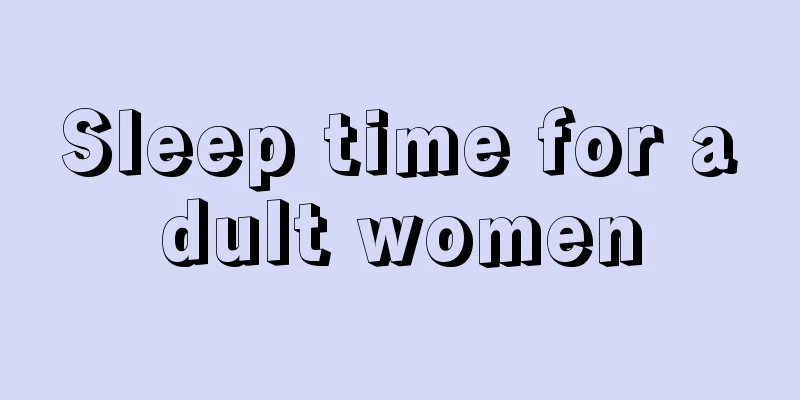Sleep time for adult women

|
The sleep time for adult women is about 8 hours, and it cannot be too short. If you are always in a state of lack of sleep, it will induce various problems. Most of them will experience memory decline and inability to concentrate completely. Therefore, you still need to ensure deep sleep to improve your brain's intelligence and allow you to live and work normally. Sleep is a spontaneous and reversible resting state that occurs periodically in higher vertebrates, characterized by a decrease in the body's responsiveness to external stimuli and a temporary interruption of consciousness. About 1/3 of a person's life is spent sleeping. When people are sleeping, their brains and bodies can rest, recuperate and recover. Appropriate amount of sleep helps people with their daily work and study. Scientifically improving sleep quality is the guarantee for people's normal work, study and life. Brain power. Slow-wave sleep According to the characteristics of human brain waves, this phase is usually divided into four different periods, corresponding to the process of sleep from light to deep. The first stage presents low-voltage brain waves with a mixture of fast and slow frequencies, with a predominant frequency of 4 to 7 cycles/second. It often occurs at the beginning of sleep and during brief awakenings at night. Non-rapid eye movement sleep is more common in the first half of the night. This is mainly because after a day of using the brain, ordinary people’s brain power is greatly depleted, which causes stress and damage to brain cells and brain tissue. The biological clock will naturally induce us to sleep, lower the brain temperature, and enter the repair stage, which is very important for maintaining life. There will be more rapid eye movement sleep in the second half of the night, which is related to study and work. When you experience many scenes, whether good or bad, in a day, you must incorporate them into your memory. Non-rapid eye movement sleep includes learning new things and integrating daytime emotions. Paradoxical sleep Paradoxical sleep refers to the situation in which the two eyeballs under the eyelids show regular left and right movement during sleep. This process occurs in a regular and staggered pattern throughout the night, which is called a sleep cycle in sleep medicine. There are 4 to 5 sleep cycles in one night. Non-rapid eye movement sleep is maintained more in the first half of the night and almost non-existent in the second half of the night; but rapid eye movement sleep becomes more and more in the second half of the night. |
<<: Treatment for blocked breast
>>: How long does it take to cure mold?
Recommend
How to treat painful urination after sex
Painful urination after sexual intercourse may be...
Can I eat dragon fruit during my period?
Women can eat pitaya during menstruation, because...
Is it easy to get pregnant before or after menstruation?
During menstruation, female friends should know t...
Postpartum uterine recovery process diagram
After giving birth, pregnant women need some time...
What is the best medicine for cervical anti-inflammatory
Cervicitis in women is a very common gynecologica...
What causes bacterial vaginitis?
What causes bacterial vaginitis? Bacterial vagini...
What is the difference between curettage and dilatation?
I believe everyone has a certain understanding of...
How long will it take for the fetus to give birth if there are uterine contractions on fetal heart monitoring?
The most important function of fetal heart rate m...
Can I eat taro during menstruation?
Many people like to eat taro. The nutritional val...
Women with light menstrual flow
In daily life, women should take comprehensive ca...
What is vaginal wall damage?
For friends who have vaginal wall damage, they re...
Anal pain after medical abortion
After medical abortion, there may be a pushing se...
How to calculate the ovulation period
Women have many normal physiological phenomena, t...
Illustration of dumbbell exercise method for girls
For many people nowadays, they live a daily routi...
Quick pain relief for tooth decay pain in pregnant women
During pregnancy, tooth decay is difficult to dea...









